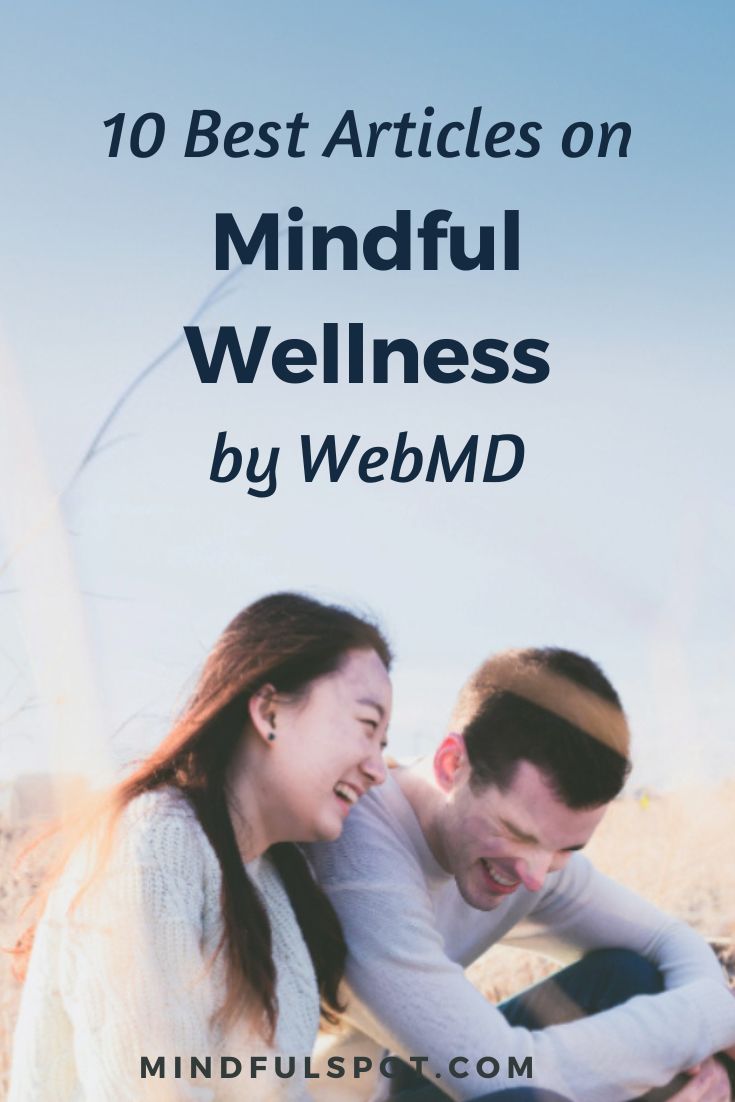WebMD is one of the leading healthcare publishers in the United States. Its core mission is to bring you the most objective and trustworthy health information.
The WebMD content staff includes individuals who hold advanced degrees in journalism, medical illustration, health communications, clinical informatics, nursing, and medicine. They always strive to give readers a variety of ways to find what they are looking for.
In this article, I bring you ten best WebMD articles on mindfulness, along with my favorite quotes.
1. “How Mindfulness Can Help Your Health”
The concept of mindfulness comes from ancient Buddhist meditation, but Westerners often practice a modern, secular form. Usually starting with deep focus on the breath, a mindful person pays full attention to the present moment and all the thoughts, feelings, and sensations associated with that moment.
“You don’t judge the moment as good or bad,” O’Leary says. “You just live it, with the knowledge that it will soon pass.” During that moment, she says, let go of any thoughts about the past, the future, or anything other than now.
What benefits does mindfulness offer? Plenty, according to recent research. It can better your test scores and working memory — the type of memory you use to do a math problem in your head. It may help improve depression, anxiety, and sleep quality, too.
Click here to read the article “How Mindfulness Can Help Your Health.”
Related book: Mindfulness for Beginners by Jon Kabat-Zinn

FREE Self-Test: How Spiritual Are You?
2. “How Mindful Meditation and Yoga Can Help Treat ADHD”
Medication and therapy are good ways to manage your ADHD symptoms. But they’re not your only options. Research now shows that mindfulness meditation — where you actively observe your moment-to-moment thoughts and feelings — may also be a good way to calm your mind and improve your focus.
More than a third of adults with ADHD use this practice, and about 40% give it high ratings, according to a 2017 survey by ADDitude magazine.
Click here to read the article “How Mindful Meditation and Yoga Can Help Treat ADHD.”
3. “Just Breathe: Mindfulness Can Beat Tech Stress at Work”
And on and on it goes, until what technology experts and psychologists call the digital dark side of technology — stress, anxiety, a feeling of being overloaded — wipes you out, jeopardizing your mental and physical health.
However, preventing that burned out feeling is possible, experts say, by practicing mindfulness, an age-old approach focused on being aware of your feelings in the moment without judgment or interpretation. Mindful breathing, for instance, focuses on paying attention to your breath as you inhale and exhale. With a mindfulness approach, workers can leverage technology so they are more productive, less stressed, and more in control.
Click here to read the article “Just Breathe: Mindfulness Can Beat Tech Stress at Work.”
Related book: Awake at Work by Michael Carroll
4. “Struggling to Fall Asleep? How to Fall Asleep With Mindfulness Techniques”
Sleep plays a massive role in maintaining your overall health. Millions of people in America have a hard time getting sound sleep. Research has found that using mindfulness techniques helps to solve sleep issues.
Mindfulness involves being aware of your thoughts, senses, feelings, and environment moment by moment. You gently accept what you are thinking and feeling without judgment.
An effective way you can use mindfulness to help you fall asleep is through mindfulness meditation. In this technique, you mainly focus on your breathing and pay attention to your present thoughts and feelings. While doing this, try not to think about your past experiences or the future. Mindfulness meditation is meant to trigger a relaxation response and take your mind off your daily issues.
Click here to read the article “Struggling to Fall Asleep? How to Fall Asleep With Mindfulness Techniques.”
5. “Six Ways Mindfulness Can Help You Lose Weight”
Mindfulness could be the key to your weight loss success. Being mindful simply means to give your full attention to your environment, thoughts, behaviors, and experiences.
“When you bring awareness to your internal and external environments, and you do so without judgment, you also have the opportunity to become more deliberate about your choices,” says Jan Chozen Bays, MD, author of Mindful Eating. Start using these six tactics today.
Click here to read the article “6 Ways Mindfulness Can Help You Lose Weight.”
Related book: Savor: Mindful Eating, Mindful Life by Thich Nhat Hanh
6. “Do Mindfulness Apps Really Help Your Health?”
Author and mindfulness instructor Tamara Levitt, who writes and records guided meditations for the Calm app (and who has studied and practiced the art for 3 decades), believes meditation, no matter how it’s delivered, can yield powerful results.
“Mindfulness is the act of paying attention to the present moment,” she says. People get in trouble with stress and anxiety, she says, because staying present can be difficult. “Our minds are often in the future, worrying about something that’s going to happen, or we’re ruminating about the past,” she says. “Meditation brings us back to the moment we’re in.”
Focusing on breathing techniques, Levitt says, is fundamental because the breath anchors our attention. “We battle anxiety because our minds are filled with fearful thoughts. Mindfulness keeps us in the present, where we can calm ourselves down.” But do users of these apps truly reap health benefits?
Click here to read the article “Do Mindfulness Apps Really Help Your Health?“
7. “Mindfulness: Stay Present and Engaged”
The term “flow” — originally coined by positive psychologist Mihály Csíkszentmihályi — describes that magical feeling you get when you’re so immersed in an activity, time seems to stand still. Even your sense of self can slip-slide away.
“Flow is a cascade of five of the most potent neurochemicals on earth,” explains Steven Kotler, author of the new book The Rise of Superman: Decoding the Science of Ultimate Human Performance. “[It] massively amplifies creativity.”
The good news? You needn’t go for gold — or even leave your couch — to get there. Here are a few ways to find more flow in your here and now.
Click here to read the article “Mindfulness: Stay Present and Engaged.”
Related book: Mindfulness and the Arts Therapies by Laury Rappaport
8. “Mindful Eating Aims to Change Your Relationship With Food”
You may be familiar with the basic steps: Slow down, notice what you’re eating, and enjoy your food. But mindful eating can be more nuanced, and if done with intention over time, it can change your relationship with food and benefit your health, experts say.
Even if you spend your day rushed – eating breakfast during your morning commute, having lunch at your desk, and heading home to dine in front of the television – you can make it work.
“Start small. Start with just one bite,” said nutritionist Linn Thorstensson, Dip NT mNTOI, director of the Center for Mindful Eating, a nonprofit organization. There are many simple ways to get started with mindful eating.
Click here to read the article “Mindful Eating Aims to Change Your Relationship With Food.”
9. “What is 4-7-8 Breathing? The Benefits of Mindful Breathing on Health and Wellness”
The 4-7-8 breathing technique is based on pranayama breathing exercises. Pranayama is the ancient yogic practice of controlling your breath. These types of mindful breathing exercises have been shown to have many benefits for stress reduction and relaxation. The 4-7-8 breathing technique was developed by Dr. Andrew Weil. He refers to it as a “natural tranquilizer for the nervous system.”
You can practice 4-7-8 breathing anywhere and at any time. When you’re first learning, try to practice at least twice a day, but you can do it as often as you want.
Click here to read the article “What is 4-7-8 Breathing? The Benefits of Mindful Breathing on Health and Wellness.”
10. “Fourteen Ways to Quiet Your Mind Explained”
We do this all the time, but to use your breathing to find stillness, be more careful and conscious about it. Pay attention to the rhythm. If you take short, quick breaths, try to move toward slower, deeper ones. Put your hand on your belly: You should feel it rise and expand as you draw air in, and fall as you let it out. Shoot for about six breaths a minute.
Click here to read the article “14 Ways to Quiet Your Mind Explained.”
Related book: The Mindful Way Through Depression by Jon Kabat-Zinn
Complement this list of best mindfulness articles by WebMD with Psychology Today articles on mindfulness, Healthline articles on mindfulness, Psych Central articles on mindfulness, Verywell Mind articles on mindfulness, Well and Good articles on mindfulness, and Everyday Health articles on mindfulness.

FREE mindfulness resources for stress relief
I’m a freelance writer and mindfulness advocate behind this blog. I started my meditation practice in 2014, and in 2017 I launched this website to share what I learn with others. Here are the three things you can do here:
1. Schedule a free consult if you want to learn Buddhist meditation.
2. Download free mindfulness resources for stress relief
3. Join Patreon for exclusive content and community meetings.









